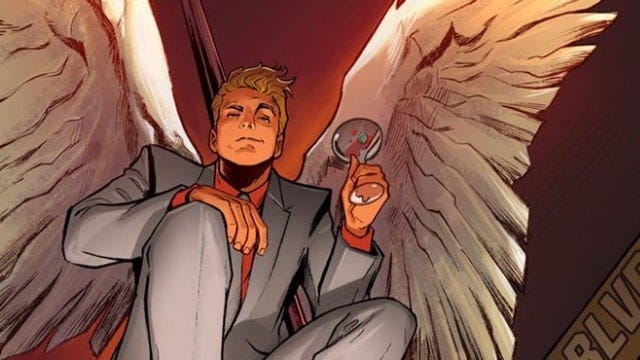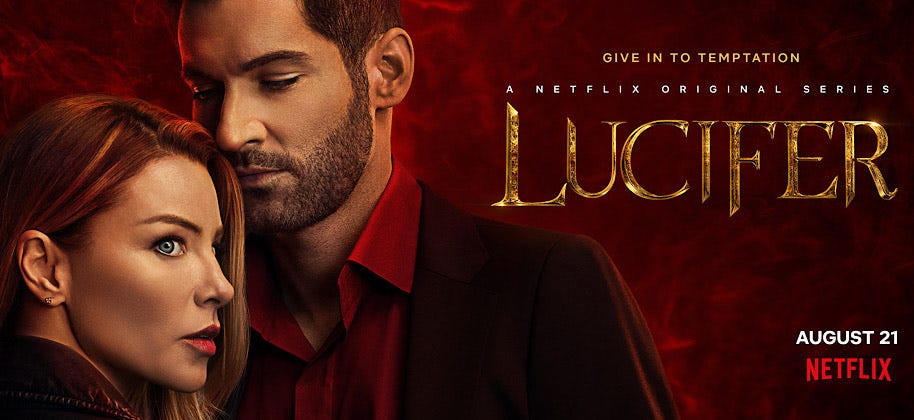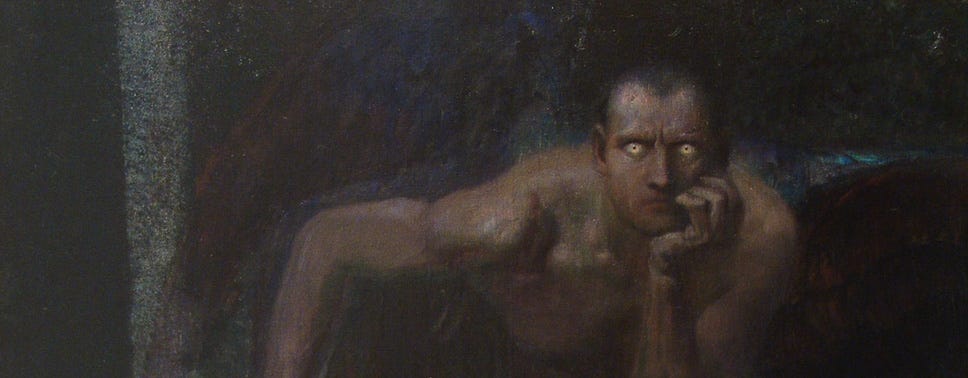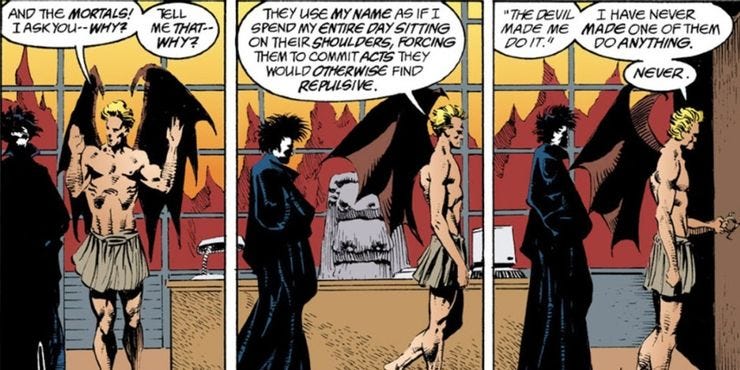Clothes Make the Devil
Hoofs, horns and sexy Lucifer's infatuation with the Late Capitalism
Whenever I return to my family in Slovakia, I enter a temple of the feminine. My mother and sister always fill me in on the latest chemical exfoliation treatments, the right shape of an eyebrow for this season, new Tik Tok filters, and other hot pop culture gossip. I remember raising eyebrows at the 50 Shades craze, Timothée Chalamet and Lil Peep worship, and a quite recent discovery, the new Netflix adaptation of Lucifer.
I usually pass these phenomena as another curious spectacle blooming on my periphery, but I have to admit; the slick, handsome still of Lucifer on the ad did catch my eye. Of course, I’m well familiar with the character coming from the Hellblazer, the Sandman universe of my beloved Neil Gaiman. After a few adjustments to fit the Netflix franchise family, Lucifer drops his horns and hoofs, jumps into a well-fitted Armani suit and drives around a Chevrolet Corvette in a cloud of Creed Aventus.
I don’t want to get into the storyline nor review the quality of a series that is expertly tailored to keep the 20-40 white middle-class female audience screaming for more with every episode. The formula is no rocket science, perfected by the experts in the genre since Danielle Stelle and Jackie Collins - rich, handsome, extremely virile man who falls for a simple girl. Someone cheats, someone tries to stop it, someone gets pregnant - the regular drama, generously peppered with steamy female-oriented sex passages. Everything’s by the textbook, only this time, your handsome millionaire happens to be the Dark Prince himself.
The Hell of Ontology
Trying to grasp the nature of the Devil is a truly challenging task. There are many divergences between the biblical figure of Satan, manifestations of ‘pure evil’ and various Promethean qualities attributed to the Serpent of the Garden of Eden or Lucifer. There are dozens of arguments to be made why this and that are not coherent with the primary sources, Christian dogma or some abstract overarching archetype from whichever esoteric school. For the sake of this article, even if we might risk some reductive simplifications - let’s just stick with the presumption that Lucifer, as represented by Netflix, is a direct continuation of the Bad Guy™ you might remember from your Catholic classes. Very few people seem to care about ontology when talking about the Devil.
So how exactly did he make his way from the frozen depths of Dante’s Hell into your elementary school teacher’s erotic fantasies?
Devil’s Political Career
The Devil has always been a very malleable and dynamic figure. The development of his character reflects the changing interpretation of the causes of evil in nature and society and the various political agendas of many involved parties.
Christianity, generally, doesn’t subscribe to the world as a Manichean battlefield of good and evil. The importance of the Devil as God’s adversary varies between theological schools of the past millennia. Some deny the existence of any principle independent of the supreme God, while others consider Satan as the main reason for the sin and corruption of the material realm - a power partially independent, but still subjugated to the greater plan of the creator. The multitude of his identities was built up by the gradual devouring of pagan religions into the Christian tradition, iterative reinterpretations and manufacture of new scriptures, and many translation errors and ambiguities that don’t make it any more straightforward. Lucifer, Satan, Samael, Serpent, Mephisto… and much more in several thousand years of theological quarrels over his family tree and very nature of his existence. To glimpse the changing face of Dark Prince, one needs to do serious archaeological work in the rich sediments of many centuries of human intellectual and spiritual effort.
The occupation of Satan and his legions were always tightly bound with the current political affairs - his alleged title, manners and character traits conveniently correspond with the preacher's agenda. The fear of the scorching hell for rebellious kept poor peasants’ suffering justified, witch hunts enforced the patriarchal power structures, and common adversary with an infernal army has always been an easy fix for a crumbling national identity. The monarch and clergy were the God-sent defenders of the order, protecting the world from descending into chaos and heresy.
One of the major shifts in the Devil’s image started during the Revolutions of 1789-1848. He became the hero of the revolutionaries, a prototypical rebel against the tyranny of the monarchy. The political power of clergy and aristocracy were swept away, industrialisation moved people from countrysides rich in religious customs into urban areas, and the traditional values crumbled under the harsh working conditions and bleak industrial landscapes. The Devil’s powers shifted and mutated, and he moved from the theological faculties and monasteries into the libraries and theatres.
The new Romantic rendering of Satan as a rebel hero brought an entirely new layer to the character. The Devil becomes an ambiguous figure, far beyond a simple Christian good-evil dichotomy.

The Faustian casting of the Devil as Mephistopheles highlighted his sarcastic and trickster aspects. He no longer considered it necessary to corrupt the world, humans managed very well themselves. The successive mythology was largely build-up by the theatre and cinema, often casting the devil as a handsome, well-educated seducer. Many artists during the past decades mixed various personal and social agendas into the pot of an already complicated enough identity.
Dressed in slick scholarly clothes, modern Devil mocks the church and its institutions, which are now often considered corrupt and far astray from the original Jesus’ teaching of universal love. The world is crumbling under inflation, fake news, hyperpolarisation of beliefs and unprecedented heat waves, while God’s representatives are caught up in a web of bigoted opinions, sex scandals and loud preoccupations with other people’s wombs and lovemaking preferences. In the current state of affairs, the affiliation with Satanic seems to be a natural reaction to two millenia of Christian cultural dominance - somehow, the polarities shifted and the Devil became the lesser evil.

The Devil in Late Capitalism
This links us to the 21st century and our polished Netflix prime-time series. Lucifer here is pushed to his new logical conclusion. The Devil seamlessly blended with a late capitalism hero, equipped with his devilish charm and platinum visa. He became a full manifestation of what Rudolf Steiner calles Ahrimanic forces. It’s a current undermining spiritual development by shifting focus fully into the material realm. Scientifism and positivism became the basic paradigm of our civilisation and our souls are starving under the constaltly growing pile of meaningless material possessions. This force is deeply intertwined with the very nature of capitalism and the strive for endless technological progress.
And here comes our charming Lucifer, the sexy millionaire, a fresh export straight from the bastion of capitalism, Los Angeles. He cleverly changed his dress and became a perfect mascot for this day and age of worship of the egomaniacal individuality. Lucifer Morningstar is riding your desires to stimulate your appetite for more mindless consumption, entrancing you in your blissful ignorance of anything beyond that. He’s infatuated with you (or any other ordinary girl on the screen) and he requires zero effort or character development from his only love interest.
Because you are special, you are the chosen one, and even the Dark Lord is beyond himself about you!
He might not be savagely raping and murdering in Lautréamont style, nor planning his next political assassination - it does appear we humans manage to f*ck up our global affairs without any assistance these days! But you have to admit that Lucifer in his new role just feels right. This is not some watered down “sort-of-a-devil” spinoff - his filthy-rich rendering sprung straight from the depths of our collective unconscious. He’s still the Devil, the Tempter, the one who leads souls astray. He changed his costume and demeanor as he found a better strategy to fulfil his purpose: as a personification of all corrupt in the power structures of the western world.
He intoxicates us with blissful ignorance of all suffering around us, by feeding our fantasies: of a heated swimming pool on the roof terrace in LA, or the perfect lover with irresistible charisma. He teaches that there are no rules or moral responsibility when you have an unlimited overdraft on your credit card. That there is nothing else of importance but one’s own pleasure and prestige, climbing of the social ladder and monetisation of every aspect of our experience.
No virtues, no kindness, no nourishment, no love.
He glitters everything that’s wrong with excessive consumerism and plants the seeds of a sarcastic nihilism that’s decimating our planet. He doesn’t care about global warming, wars, poverty, injustices. And he has ways to make you forget as well… maybe you would rather binge watch another crap series aired by Netflix?
Reading list
I highly recommend this podcast on the Devil with Nikolas Schreck, who’s very knowledgable on an incredible amount of otherworldly topics.
More on the Devil in cinema can be found in his book Satanic Screen. The german version dropped earlier this year and can be purchased here. A new english edition will be released later this year, so keep an eye on his Instagram for more updates.
Dr. Rudolf Steiner’s lecture series on Ahriman and Lucifer is definitely worth a read (or a listen). It analyzes various negative influences on human spiritual development and their effects on the society in general.
J. B. Russell’s The Prince of Darkness is a dense overview of the radical evil in history, tracing the development of the Devil through the dawn of humanity till today. It’s a concise version of the full series, which contains also Mephistopheles, more focused on the Devil’s disguises in modern times.
If you’re interested to read more about the Satanic in the contemporary occulture, the publication Satan Superstar from Reprobate Press might be your landing spot.
Please, even with the recommended sources, check your facts. Every writer has an agenda and the Devil is always happy to make a fool out of you.
Hope you enjoyed, and thank you for giving me a little bit of your precious time and attention. Please do share your thoughts, or hit that lil ❤️ at the top of the article - it’s very satisfying to know that someone appreciates my writing.
Stay kind,
k.







